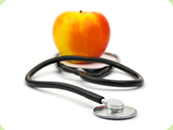|
Feeding picky eaters
A common complaint by today's parents is that their children will only eat certain foods, and those foods usually happen to be unhealthy (the more fat you eat, the more your body will crave it; same with sugar and salt). To combat this vicious cycle, you can try multiple things:
|
1. Sneak in healthy smoothies: most kids like shakes and will take to a smoothie right away. The best part of smoothies is that many healthy ingredients can be snuck in, including foods your child would refuse on their own; the trick is really only in the amount you add and you can experiment with what works for you child. Start off with a few staples - raw or frozen berries (cherries and mango chunks also work well) and a banana. Then you can add a few leaves of raw greens such as kale or spinach, ground flax seeds, any liquid vitamins such as B12 or vitamin D, and/or ground nuts such as almonds (you can buy almond meal preground), pecans, or walnuts. Then add orange juice or soy (or other non-dairy) milk and blend. To cover stronger amounts of greens or just to mix it up, add some soy yogurt.
2. Try plant-based versions of your child's favorite foods: veggie burger instead of a regular burger; veggie hot dog instead of a meat one; soy or rice shake made with real fruit, instead of a milkshake; veggie turkey/ham/bologna instead of the deli counter; whole grain soy-cheese pizza with their favorite veggies (or pineapple) on top.
3. Soups are a great way to feed beans and veggies to children reluctant to eat these on their own, as well as add a lot of garlic and onion (excellent cancer-fighters) into the diet. Try Butternut Squash Soup, or make one of your own. If your child is averse to textures, try putting some steamed broccoli (or other cooked veggies) into the blender, add some soy milk, and salt/pepper to taste for a healthy, creamy soup.
4. Dips tend to go over well with kids because it gives them a chance to "play" as they eat. You can put out some hummus in a personal dish, cut up some veggies (try sweet bell peppers, carrots, cucumbers, olives, lettuce, cherry tomatoes, pickles, etc) and some whole grain crackers/pita/flatbread, and let them go to town. Another idea is applesauce with graham crackers or apple slices with peanut butter.
|
Feeding babies and toddlers just starting to eat solid foods
The major difference here is that babies and toddlers won't be able to chew tougher textures yet, nor eat skins on fruits. Most veggies can be cooked until soft and palatable, and there's no reason you can't add cooked beans into a blender and mix it all to a creamy consistency that baby can eat. Soy or rice yogurts and soft (blended) tofu will also work, and nuts, once safely introduced, can be ground and added to yogurts and smoothies just like for older kids. Avocadoes work very nicely in many smoothies providing extra fat and creaminess, such as in the Avocado Banana Berry Smoothie. Remember to add liquid B12 once a baby is older than 5 months (unless drinking B12 fortified formula). From one year on, she/he may start to receive some or all of the B12 requirement from fortified soy/rice milk or other fortified foods - check the B12 dosing schedule.
Getting enough calories
Parents tend to worry about children getting enough calories on a vegan diet. As long as the diet is balanced, this should not be a concern. One note is that young children need fats moreso than adults because they are growing. But they need healthy fats, which are not those found in animal products, nor hydrogenated or trans fats. These healthy fats are found in nuts, beans, avocadoes, olive and other plant oils. Beans, tofu, quinoa, and lentils are great sources of protein and calories, as is brown rice and whole grain breads and pastas. Dried fruits also offer compact calories in a healthy package.
>> For more tips on feeding children and school lunch box ideas, please see Vegetarian Diets: Advantages for Children.
>> For a detailed breakdown on feeding vegan children, please see Feeding Vegan Kids by Reed Mangels, PhD, RD. Be sure to scroll down for meal plans and feeding schedules for babies and older children. |
 |
|



